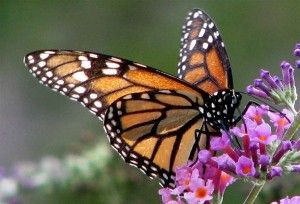Michoacan, Mexico - The number of Monarch butterflies migrating to central Mexico has plummeted by 59 percent in the last year, according to the annual census released earlier this month.
Illegal logging, the use of herbicides, and climate change are all thought to have contributed to the sixth drop in butterfly numbers in the last seven years, with the Monarch population in Mexico now only one-fifteenth of that in 1997.
Every year millions of the distinctive orange and black butterflies make the epic journey from Canada and the United States to settle for the winter in the mountainous fir forests of Michoacan and the State of Mexico.
It is an extraordinary migration, with none of the butterflies making the entire round trip. The journey is completed with remarkable precision by several generations of butterflies, most of whom live for no more than eight weeks. Arriving in Mexico in late fall, they begin the northward return journey in mid-March.
Due to the sheer quantity of butterflies that settle in and around Michoacan’s Monarch Butterfly Reserve, the insects are counted by the amount of forest they cover. This winter they covered just 2.93 acres, the lowest figure since records began 20 years ago and 59 percent down from last year’s 7.14 acres.
The figures confirm a long-term statistical trend, which the World Wildlife Fund (WWF) blames primarily on the extensive use of herbicides that kill off milkweed, the Monarchs’ main food source, in their breeding grounds in the United States and Canada.
 |
In recent years farmers have increasingly used herbicides to kill off all plants in their fields except for their genetically modified corn and soybean crops, but the ensuing destruction of milkweed is extremely damaging for the butterflies that lay their eggs on the plant and rely upon it as an essential food which also provides a poisonous toxin that makes them unpalatable to birds and other predators.
"The conservation of the Monarch butterfly is a shared responsibility between Mexico, the United States, and Canada. By protecting the reserves and having practically eliminated large-scale illegal logging, Mexico has done its part," Omar Vidal, the director of the WWF in Mexico, said recently. "It is now necessary for the United States and Canada to do their part and protect the butterflies’ habitat in their territories."
Illegal deforestation in Mexico had long been considered a major factor in the decline in butterfly numbers, but an aerial survey in 2012 showed almost no detectable logging for the first time since 200 square miles of mountaintop forests were declared a protected nature reserve in 2000.
But not everyone is convinced that Mexico has done enough to stop illegal logging. Having studied Monarch migration for 55 years and personally witnessed the continuation of small-scale logging in the Michoacan sanctuary on a visit in February, US entomologist Lincoln Brower issued a statement declaring it misleading "to blame the low numbers of monarchs solely on what is happening north of Mexico."
Brower said that even small reductions of the forest cover can expose the butterflies to potentially fatal lower temperatures, humidity, and direct sunlight. He added that local communities are being allowed to pipe water out of streams, with disastrous effects for the butterflies which do not drink water throughout their migration until they reach Mexico.
Climate change has also proven a factor in the declining butterfly numbers. Unusually hot temperatures in the United States early last year upset the Monarchs’ breeding patterns, while the hot, arid summer dried out and killed their eggs, as well as reducing the nectar content of flowers.

